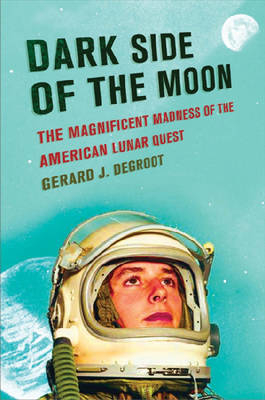
Dark Side of the Moon
The Magnificent Madness of the American Lunar Quest
Seiten
2006
New York University Press (Verlag)
978-0-8147-1995-4 (ISBN)
New York University Press (Verlag)
978-0-8147-1995-4 (ISBN)
- Lieferbar
- Versandkostenfrei
- Auch auf Rechnung
- Artikel merken
Exposing the truth behind one of the most revered fictions of American history, Dark Side of the Moon explains why the American space program has been caught in a state of purposeless wandering ever since Neil Armstrong stepped on the moon.
A selection of the History, Scientific American, and Quality Paperback Book Clubs For a very brief moment during the 1960s, America was moonstruck. Boys dreamt of being an astronaut; girls dreamed of marrying one. Americans drank Tang, bought "space pens" that wrote upside down, wore clothes made of space age Mylar, and took imaginary rockets to the moon from theme parks scattered around the country. But despite the best efforts of a generation of scientists, the almost foolhardy heroics of the astronauts, and 35 billion dollars, the moon turned out to be a place of "magnificent desolation," to use Buzz Aldrin's words: a sterile rock of no purpose to anyone. In Dark Side of the Moon, Gerard J. DeGroot reveals how NASA cashed in on the Americans' thirst for heroes in an age of discontent and became obsessed with putting men in space. The moon mission was sold as a race which America could not afford to lose. Landing on the moon, it was argued, would be good for the economy, for politics, and for the soul. It could even win the Cold War. The great tragedy is that so much effort and expense was devoted to a small step that did virtually nothing for mankind.
Drawing on meticulous archival research, DeGroot cuts through the myths constructed by the Eisenhower, Kennedy, and Johnson administrations and sustained by NASA ever since. He finds a gang of cynics, demagogues, scheming politicians, and corporations who amassed enormous power and profits by exploiting the fear of what the Russians might do in space. Exposing the truth behind one of the most revered fictions of American history, Dark Side of the Moon explains why the American space program has been caught in a state of purposeless wandering ever since Neil Armstrong descended from Apollo 11 and stepped onto the moon. The effort devoted to the space program was indeed magnificent and its cultural impact was profound, but the purpose of the program was as desolate and dry as lunar dust.
A selection of the History, Scientific American, and Quality Paperback Book Clubs For a very brief moment during the 1960s, America was moonstruck. Boys dreamt of being an astronaut; girls dreamed of marrying one. Americans drank Tang, bought "space pens" that wrote upside down, wore clothes made of space age Mylar, and took imaginary rockets to the moon from theme parks scattered around the country. But despite the best efforts of a generation of scientists, the almost foolhardy heroics of the astronauts, and 35 billion dollars, the moon turned out to be a place of "magnificent desolation," to use Buzz Aldrin's words: a sterile rock of no purpose to anyone. In Dark Side of the Moon, Gerard J. DeGroot reveals how NASA cashed in on the Americans' thirst for heroes in an age of discontent and became obsessed with putting men in space. The moon mission was sold as a race which America could not afford to lose. Landing on the moon, it was argued, would be good for the economy, for politics, and for the soul. It could even win the Cold War. The great tragedy is that so much effort and expense was devoted to a small step that did virtually nothing for mankind.
Drawing on meticulous archival research, DeGroot cuts through the myths constructed by the Eisenhower, Kennedy, and Johnson administrations and sustained by NASA ever since. He finds a gang of cynics, demagogues, scheming politicians, and corporations who amassed enormous power and profits by exploiting the fear of what the Russians might do in space. Exposing the truth behind one of the most revered fictions of American history, Dark Side of the Moon explains why the American space program has been caught in a state of purposeless wandering ever since Neil Armstrong descended from Apollo 11 and stepped onto the moon. The effort devoted to the space program was indeed magnificent and its cultural impact was profound, but the purpose of the program was as desolate and dry as lunar dust.
Gerard J. DeGroot is professor of modern history at the University of St. Andrews, in Scotland. He is the author of ten books, most recently The Bomb: A Life, which won the prestigious [2004] Westminster Medal for the best book on a war or military topic.
ContentsAcknowledgmentsPreface1 Fly Me to the Moon 2 Slaves to a Dream 3 What Are We Waiting For?4 Sputnik 5 The Red Rocket's Glare6 Muttnik 7 Rocket Jocks 8 Before This Decade Is Out 9 The Sleep of Reason Produces Monsters 10 Lost in Space 11 Sacri?ces on the Altar of St. John 12 Merry Christmas from the Moon13 Magni?cent Desolation 14 Nothing Left to Do Notes Bibliography Index About the Author
| Erscheint lt. Verlag | 1.11.2006 |
|---|---|
| Verlagsort | New York |
| Sprache | englisch |
| Maße | 152 x 229 mm |
| Themenwelt | Sachbuch/Ratgeber ► Natur / Technik ► Weltraum / Astronomie |
| Geschichte ► Teilgebiete der Geschichte ► Kulturgeschichte | |
| ISBN-10 | 0-8147-1995-3 / 0814719953 |
| ISBN-13 | 978-0-8147-1995-4 / 9780814719954 |
| Zustand | Neuware |
| Haben Sie eine Frage zum Produkt? |
Mehr entdecken
aus dem Bereich
aus dem Bereich
der stille Abschied vom bäuerlichen Leben in Deutschland
Buch | Hardcover (2023)
C.H.Beck (Verlag)
CHF 32,15
vom Mittelalter bis zur Gegenwart
Buch | Softcover (2024)
C.H.Beck (Verlag)
CHF 16,80


